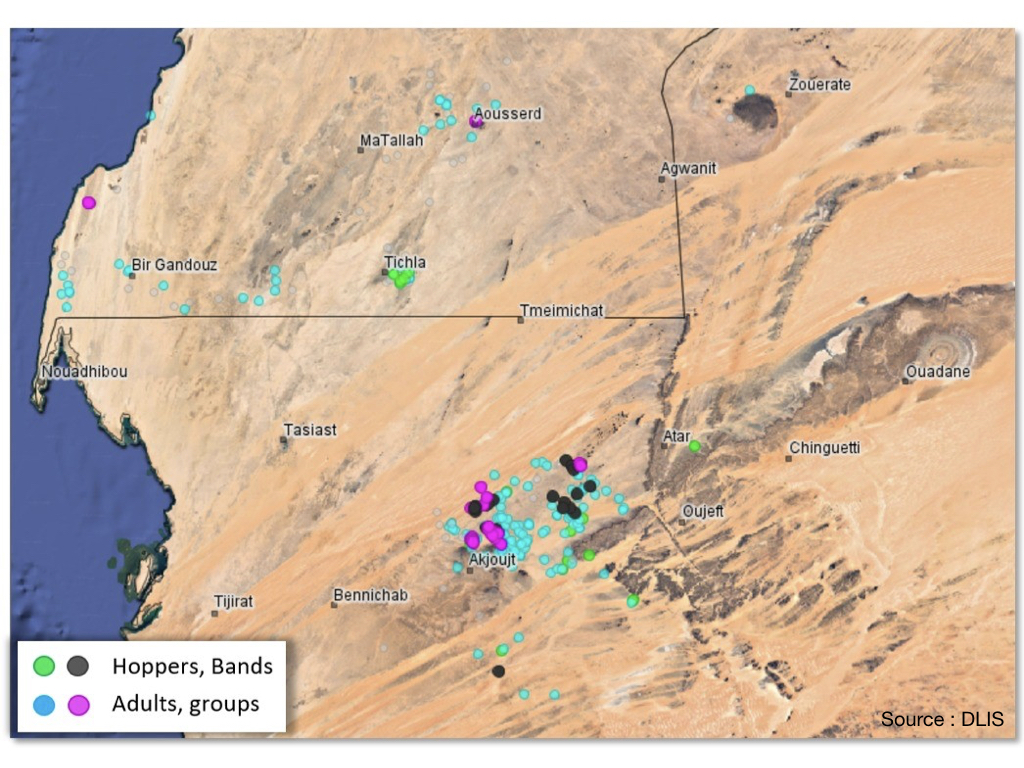5 December 2023. Central region outbreak
KEY POINTS
• Current situation: Outbreaks developed, groups, bands, and breeding: Eritrea, Saudi Arabia, Somalia, Sudan
• Current situation: The first generation of winter season (Nov–Jan) on the Red Sea and the Gulf of Aden coasts
• Control: operations in Eritrea, Mauritania, Saudi Arabia, Somalia, Sudan
• November–February: above-normal rains and perhaps a second generation of breeding (Feb–Apr) on the Red Sea and the Gulf of Aden coasts
________________________
Central Region outbreaks in November.
Four local Desert Locust outbreaks developed during November.
The winter season started earlier than normal this year along the Red Sea and Gulf of Aden coasts due to the Indian Ocean Dipole and El Niño in the Horn of Africa. A few swarms laid in Sudan and Somalia while groups occurred in Eritrea and Saudi Arabia. Hatching started and hopper groups and bands increased during the breeding in Sudan, Eritrea, Somalia, and Saudi Arabia where control was done. Yemen had some hoppers and adults while Egypt had a few adults. In the Western Region, low numbers of adults were seen in Mauritania, Niger, Western Sahara, and Algeria.
During the forecast, breeding will cause locusts to increase during the first generation along the Red Sea and Gulf of Aden coasts from December and January. The latest weather models predict more rain than normal along both sides of the Gulf of Aden and perhaps the southern Red Sea coast, but the northern Red Sea coast is uncertain. Nevertheless, a second generation of breeding is expected from late January to April which would cause locust numbers to increase further with more groups, bands, and some swarms to form. Control operations should continue.
No significant development is likely in the Western and Eastern Regions.
See LocustWatch: www.fao.org/ag/locusts
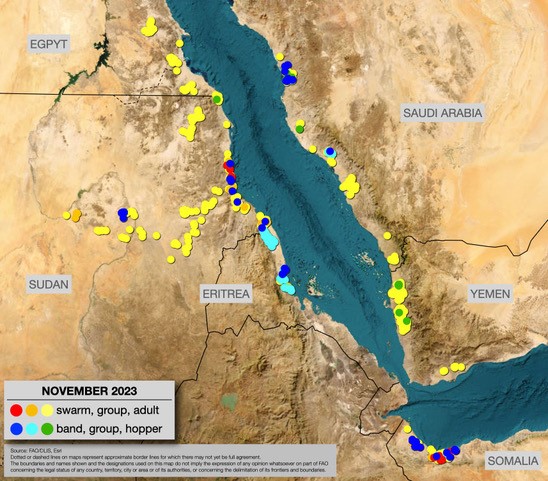
13 November 2023. Winter breeding started in the Red Sea and Gulf of Aden
OVERVIEW. The winter season has started on the Red Sea coast and the Gulf of Aden where good rains have fallen in parts of southeast Egypt, Sudan, Eritrea, Saudi Arabia, Yemen, and northwest Somalia. Above-normal rains are predicted during November and December. The first generation of hoppers and adults will occur now with a second generation starting at the beginning of January 2024 and continuing until about March or April. For preventive control, operations are mainly in Sudan and Saudi Arabia, some biopesticides in Somalia, and eventually some in parts of Yemen, Egypt, and Eritrea.
WHY IT MATTERS. The winter rainy season starts at the end of October this year along the Red Sea and Gulf of Aden coast which is about one to two months early than normal. In addition, there was a cyclone in eastern Yemen during the last week of October where some locusts could breed in the Empty Quarter. This year, there is El Niño and the positive phase of the Indian Ocean dipole in Eastern Africa, mainly in south-central Somalia and Kenya. Nevertheless, rain has fallen in parts of northwest Somalia which is the Desert Locust recession area. Consequently, surveys should be done in all of the winter breeding areas using eL3/eL3mPRO, collect the data, and decide the right time to do control.
SITUATION. Mainly locusts in Sudan and Saudi Arabia, some in Yemen, Somalia and Egypt.
• EGYPT. Isolated immature solitarious adults in the subcoastal areas of the southeast coast.
• MAURITANIA. Isolated immature and mature solitarious adults on the northwest and north; isolated hoppers.
• SAUDI ARABIA. Scattered immature and mature solitarious adults on Red Sea coast; some solitarious, transient and groups copulating, a few hoppers; treated 400 ha.
• SOMALIA. Scattered and groups of solitarious, transient, and gregarious mature adults and hopper groups on the northwest coast; waiting for current data.
• SUDAN. Scattered immature and mature solitarious adults west of Red Sea Hills and along Red Sea coast; one group near Karora and Eritrea border, one laying swarm north of Suakin; one band of 30 ha treated along Nile Valley.
• YEMEN. Scattered immature and mature solitarious adults Red Sea coast and some along the Gulf of Aden; a few solitarious hoppers on the Red Sea coast.
FORECAST. Maintain current efforts for survey and control as above-normal rains are expected to continue.
• Central Region. More rain, laying, hatching, and hoppers are expected on the Red Sea coast mainly of Sudan and Saudi Arabia with less in Yemen Red Sea coast, Gulf of Aden, northwest Somalia, southeast Egypt, and Eritrea. Groups and control are likely in Sudan, Saudi Arabia and Somalia. Some locusts may breed in the Empty Quarter.
• Western Region. Low numbers of hoppers and adults in the northwest and scattered adults in northern Mauritania; perhaps a few adults in southern Western Sahara. No significant developments are likely.
• Eastern Region. No significant developments from November to January.
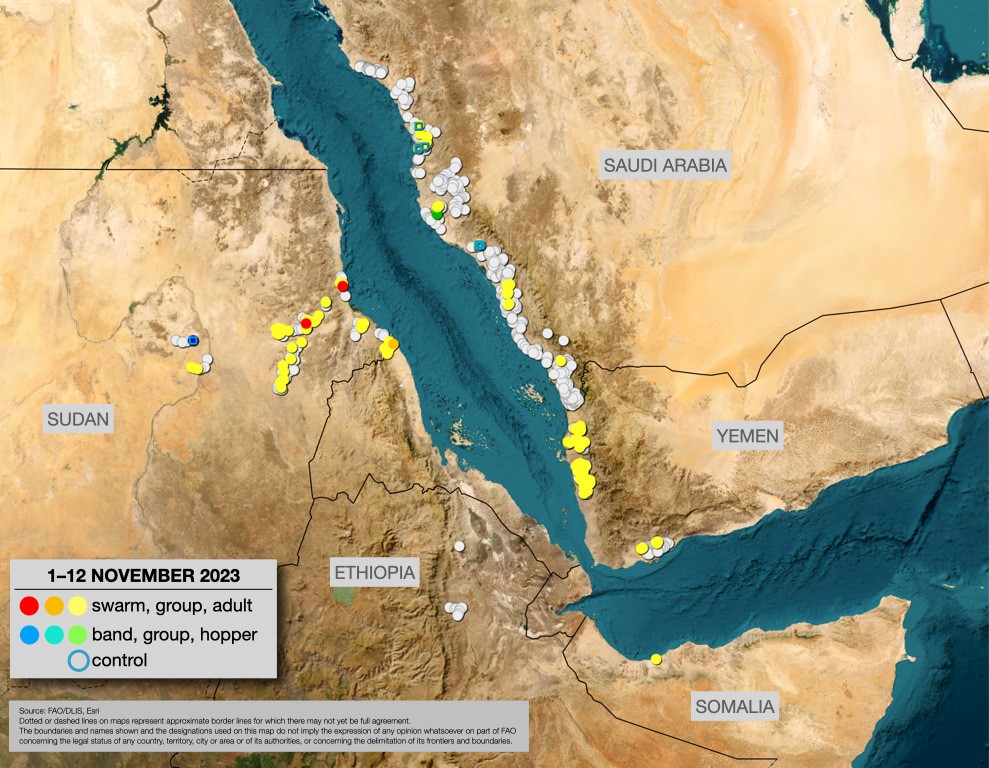
2 November 2023. Beginning of winter season
KEY POINTS
• Current situation (breeding): Saudi Arabia, Sudan, Yemen.
• Current situation: The summer season has nearly finished in the northern Sahel from Mauritania to Sudan; the winter season is starting on the Red Sea and the Gulf of Aden coasts.
• Control: operations in Saudi Arabia, Sudan, Yemen.
• November–February: above normal rains in winter breeding areas for small-scale breeding in the Red Sea and the Gulf of Aden coasts (Egypt, Eritrea, Saudi Arabia, Somalia, Sudan, Yemen).
________________________
The Desert Locust situation was mainly calm during October.
Summer breeding continued where small hopper and adult groups, bands and swarms occurred in the interior of Sudan while adults appeared on the Red Sea coast. In Saudi Arabia, hopper groups, bands, and adult groups were seen in two areas on the Red Sea coast while adults were seen on the coast of Yemen. Isolated hoppers and adults were present in Mauritania, Niger, and Chad. Cyclone Tej brought heavy rains to eastern Yemen where it moved inland to the Empty Quarter similar to May and October 2018. Winter breeding started in the Gulf of Aden and the Red Sea coast of Yemen.
During the forecast, above-normal rains are expected along both sides of the Red Sea and Gulf of Aden during November and December. The first generation of the winter breeding will occur now with a second generation starting at the beginning of January 2024 and continuing until about March or April if more rain falls. Locusts will increase with some small groups developing. Some control is expected in Sudan, Saudi Arabia, Yemen and perhaps in Eritrea, Egypt, and northwest Somalia. In the Western Region, locusts will decrease and only a few adults are likely to persist in northwest and north Mauritania and southern Western Sahara.
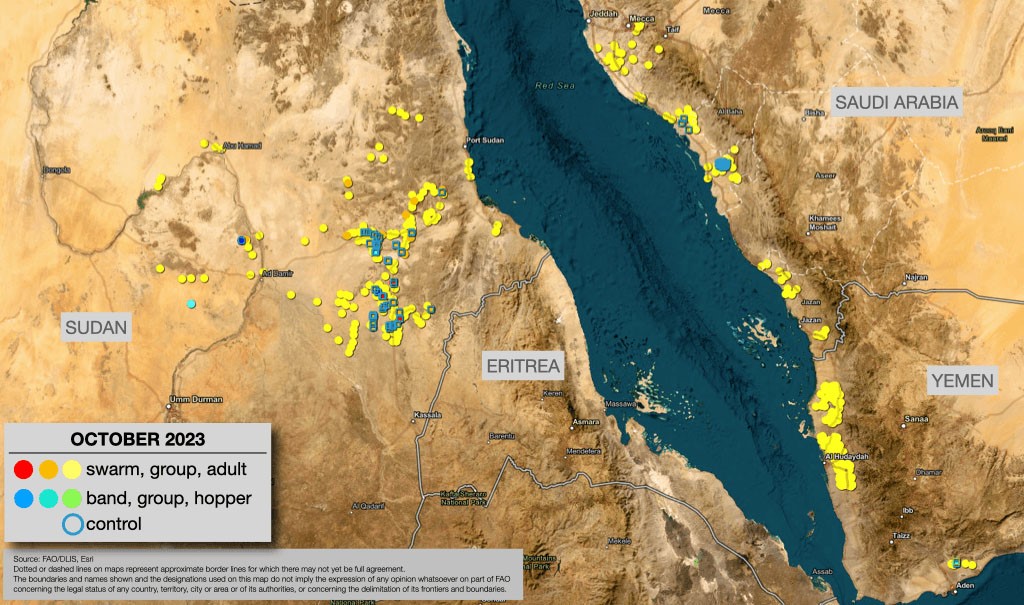
4 October 2023. Summer breeding
KEY POINTS
• Current situation (breeding): Chad, Mauritania, Oman, Saudi Arabia, Sudan
• Current situation: A few swarms in Ethiopia, Sudan, Yemen; Groups in Oman, Saudi Arabia, Sudan; Adults in Chad, Egypt, Mauritania, Morocco, Niger, Pakistan, Somalia
• Control: small operations in Ethiopia, Oman, Saudi Arabia, Sudan
• October–November: above normal rains in summer breeding areas for small-scale breeding in northern Sahel (Mauritania to western Eritrea)
• Winter season: starts earlier than normal this year on both sides of the Red Sea and Gulf of Aden coast from October to February
________________________
The Desert Locust situation was mainly calm during September.
Summer breeding occurred in Sudan, Saudi Arabia, Oman, Mauritania, and Chad. A few small groups, bands and swarms occurred in the interior of Sudan, a couple of swarms in Yemen and Ethiopia, and some control in Sudan, Saudi Arabia, Ethiopia, and Oman. Isolated adults were in Niger, Morocco, Egypt, Somalia, and Pakistan. The southwest monsoon withdrew in Indo-Pakistan, and the summer seasons ended because of deficient rainfall.
During the forecast, this year’s summer season is expected to continue longer than usual in a few places of the northern Sahel near northwest Mauritania, Mali, Niger, and Sudan due to above-normal rains predicted in October and November. During the winter season, locusts from the interior of Sudan and Yemen will move to the Red Sea coast where above-normal rains are anticipated during the last dekad of October. As a result, the first generation of breeding will start, especially in Sudan where there may be groups of hoppers and adults, as well as in Saudi Arabia, Yemen and northwest Somalia, and continue until about March.
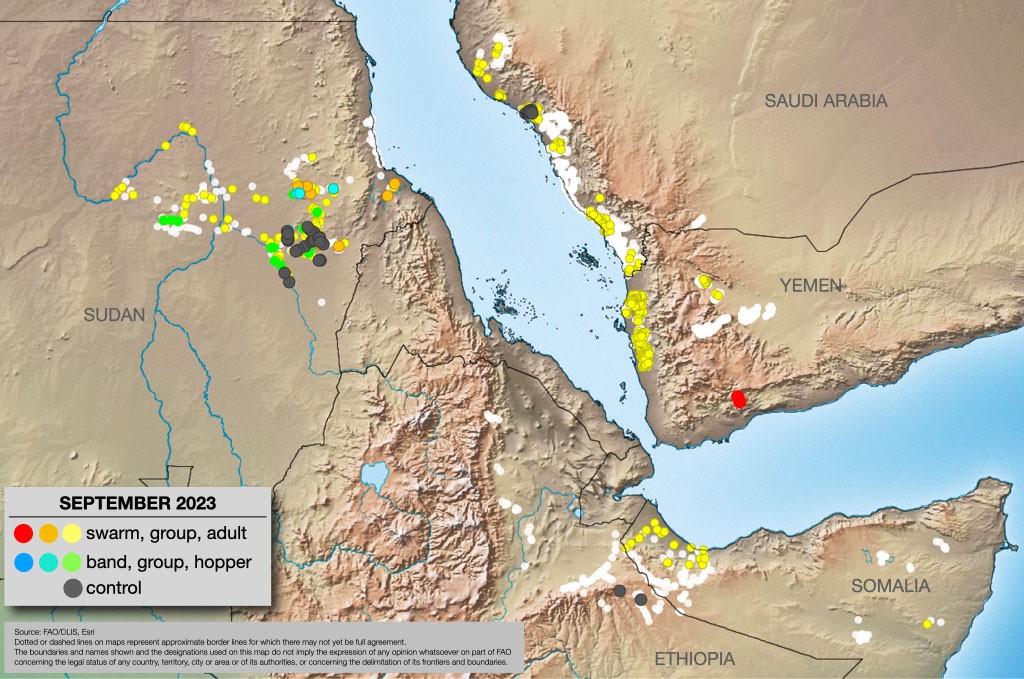
4 September 2023. Locust in Ethiopia
KEY POINTS
• Current situation: mainly adult groups and a few swarms in Eritrea, Ethiopia, Yemen; low numbers of adults in Algeria, Egypt, India, Mauritania, Morocco, Niger, Oman, Pakistan, Saudi Arabia, Somalia; a few hoppers in India, Mauritania, Sudan
• Control: small operations in Eritrea, Ethiopia, India, Morocco, Oman, Sudan
• September–November: above normal rains in summer breeding areas for small-scale breeding in northern Sahel (Mauritania to western Eritrea); below normal in Yemen and Indo-Pakistan
• September and October: scattered hoppers become adults
• Winter season: start earlier than normal this year on both sides of the Red Sea and Gulf of Aden coast from October to February
________________________
The Desert Locust situation was mainly calm during August.
A few small immature swarms migrated from Eritrea in the first days of the month to the highlands of northeast Tigray in Ethiopia and continued to the lowland areas of the Rift Valley where there were control operations. In Yemen, a few immature groups and swarms were seen in the interior, a few adult groups and hatching were in Sudan, and a few adults in Egypt while Oman had adults, a group, and laying.
In the northern Sahel of West Africa, a few hoppers and adults were present in Mauritania while adults were in Niger. There were a few adults in Morocco and Algeria.
Scattered locusts were seen on the border of Indo-Pakistan and hoppers occurred in Rajasthan, India.
During the forecast, above-normal rains and small breeding are expected to continue in the northern Sahel from Mauritania to western Eritrea until about November which is longer than normal this year. Good rains are likely to occur during the winter season where breeding will start earlier than normal this year in October in the Red Sea and Gulf of Aden coast from Sudan to northwest Somalia and from Saudi Arabia to Yemen. In the Indo-Pakistan area, below-normal rains are expected, and the southwest monsoon should withdraw by the end of September.
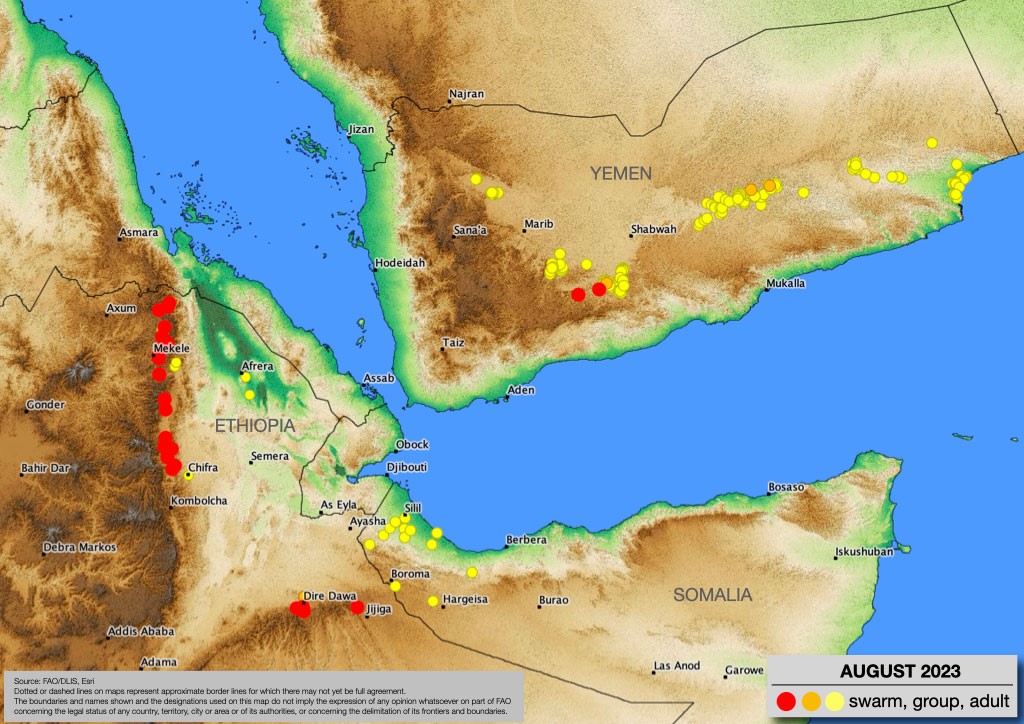
16 August 2023. Locust in Ethiopia
In Eritrea, there was breeding in June on the central coast of the Red Sea coast. When vegetation started to dry out in July, some immature adult groups moved to the Eritrea highland while others probably moved further south on the coast. On 26 July, some immature adults were found in the lowland area in western Afar north of Chifra in Ethiopia and, three days later, a small group of immature were seen at Chifra.
During the first week of August, a few small immature swarms appeared on the Tigray highland east of Adigrat and some moved further south to southeast Tigray near Korem. During the second week, a few small immature swarms were on the highland in the central parts of eastern Tigray to the north and south of Mekele. Some rains fell in parts of Tigray since last month. So far, 395 ha treated.
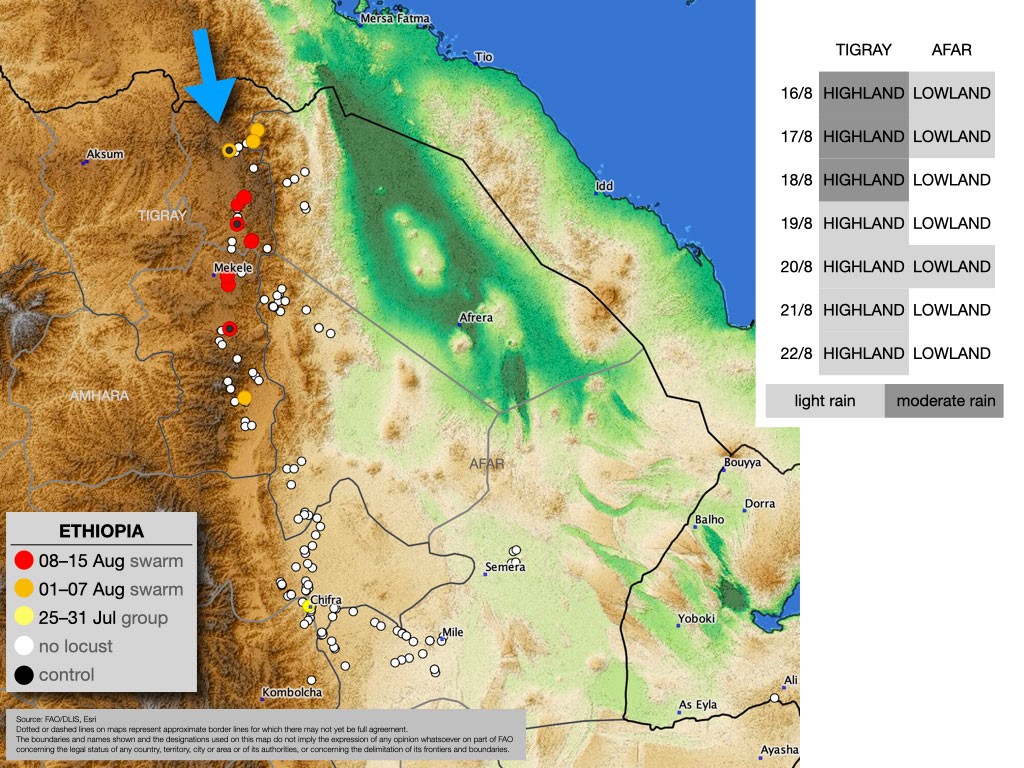
2 August 2023. Locust in Yemen
KEY POINTS
• Current situation: mainly adult groups and control in Yemen, Sudan, Eritrea; low numbers of adults in Algeria, Mauritania, Niger, Egypt, Ethiopia, Somalia, Oman, Pakistan, India
• August–October: above normal rains in summer breeding areas for small-scale breeding in northern Sahel (Mauritania to western Eritrea); below normal in Yemen and Indo-Pakistan
• August: one generation of summer breeding with low numbers of hatching and hoppers; perhaps a few small groups/swarms in northern Ethiopia in early August
• September: scattered hoppers and fledgling (after mid-month)
________________________
The Desert Locust situation was mainly calm during July.
As a result of the end of spring breeding and control in Saudi Arabia, small groups and swarms arrived in northern Yemen and moved throughout the interior of the country where there was control. Hoppers and adult groups were treated in the Nile Valley of Sudan and on the Red Sea coast of Eritrea where some moved into the highland. Adults were seen in northeast Ethiopia, northwest Somalia, and southern parts of Oman and Egypt.
In the western region, adults were seen in the northern Sahel of Mauritania where the first summer generation of hoppers appeared during the second half of the month. A few adults were present in Niger. Spring control operations finished in Morocco and only a few adults were seen in Algeria.
The southwest monsoon arrived in Indo-Pakistan and a few adults were present.
During the forecast, good rain should occur in the northern Sahel from Mauritania to western Eritrea where small breeding will take place with scattered hoppers during August and September followed by fledging after mid-September. During early August, perhaps a few small groups or swarms in northern Ethiopia. According to model forecasts, only a little rain may occur in the summer breeding areas of Yemen and Indo-Pakistan.
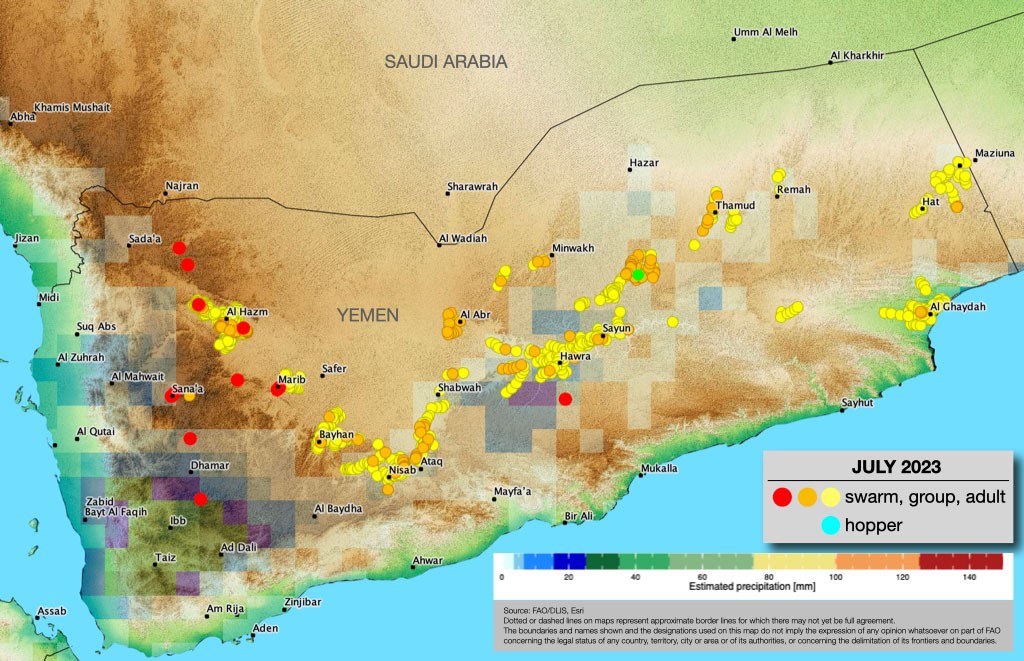
3 July 2023. Caution in Western region
KEY POINTS
• Current situation: mainly adult groups and control in Saudi Arabia, Morocco, Algeria, Mauritania, Egypt.
• July–September: above normal rains in summer breeding areas for small-scale breeding in northern Sahel; slightly above or normal in Yemen; below normal in Indo-Pakistan.
________________________
SUMMER RAINS STARTED EARLY
The Desert Locust situation was mainly calm during June.
Control operations continued in Saudi Arabia where late instar hoppers, groups, and bands became groups of immature adults in the interior and parts of the Red Sea coastal area. In Yemen, scattered adults were seen in the interior as well as in parts of the highland and northern Red Sea coastal areas. Hoppers and solitarious adults were on the Red Sea coast of Eritrea while control operations occurred in a few places on the southeast Red Sea coast and Nile Valley in Egypt.
In Northwest and Western Africa, a few control operations occurred in Morocco and Algeria where groups of immature adults were present. In Mauritania, small groups of immature adults arrive in the northwest from further north and some control was done.
There was a cyclone on the coast of southeast Pakistan and nearby India.
During the forecast, locusts will decline in Saudi Arabia, Morocco, and Algeria due to increasing temperatures and very little or no rainfall. However, locust numbers should increase slightly in the summer breeding area in the northern Sahel from Mauritania to western Eritrea. Small-scale breeding could occur in parts of Yemen and the Indo-Pakistan border if more rains fall.
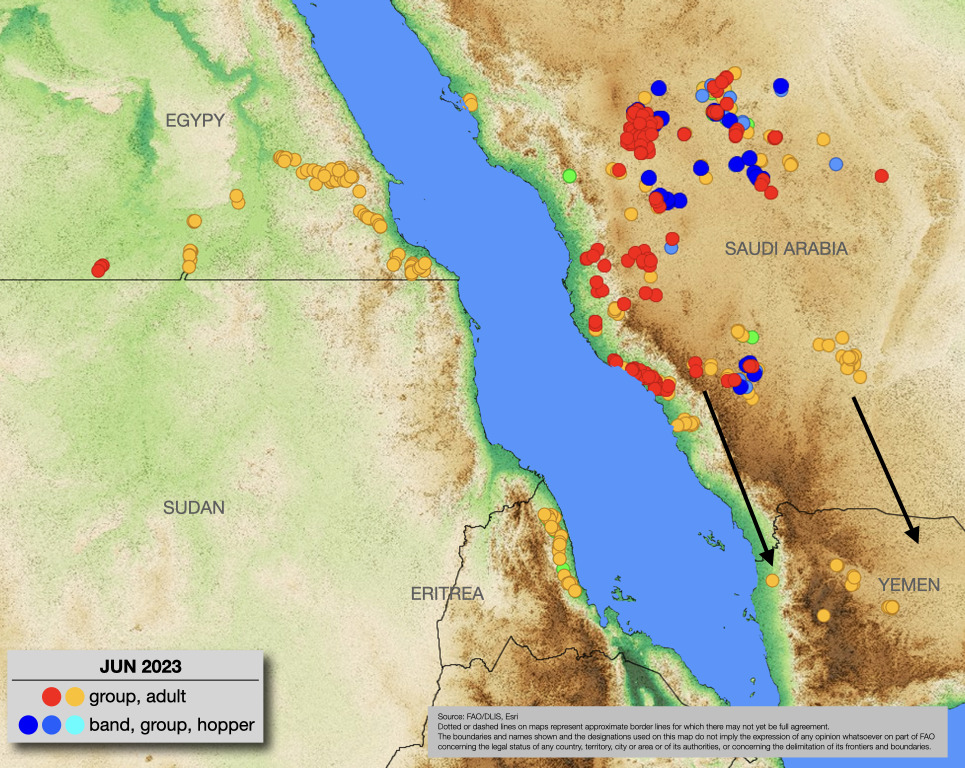
5 June 2023. Caution in Western region
KEY POINTS
• CAUTION: Saudi Arabia and Northwest Africa
• Current situation: mainly adult groups and control in Saudi Arabia, Morocco, Western Sahara, Algeria
• June: immature adult groups likely move to southern Mauritania and become scattered
• June–September: above normal rains in summer breeding areas for small-scale breeding in northern Sahel; slightly above or normal in Yemen; below normal in Indo-Pakistan
________________________
Control operations increased during the spring season in Northwest Africa and Saudi Arabia in May.
In Saudi Arabia, breeding continued on the central and northern Red Sea coast as well as in the interior where hopper groups and bands and immature adult groups were controlled by air and ground. As temperature increases and no rains are expected, adult groups should decline and move south. In Yemen, small-scale breeding may occur in the interior.
In Northwest Africa, hopper groups and bands and immature adult groups occurred south of the Atlas Mountains in Morocco as well as further south in Western Sahara. Some of the immature adult groups arrived in western Algeria and northern Mauritania. Control was carried out in all areas. During the forecast, any adult groups that are not controlled in the northwest will move south in June to Southern Mauritania where they are likely to disperse as scattered adults.
The summer rains are expected to begin in the Northern Sahel early this year in about mid-June, which means that breeding should start in early July. A few groups could also scatter and breed in Southern Algeria, Northern Mali, and Niger.
Elsewhere, small-scale breeding may occur in the interior of Sudan and Western Eritrea once rainfall starts.
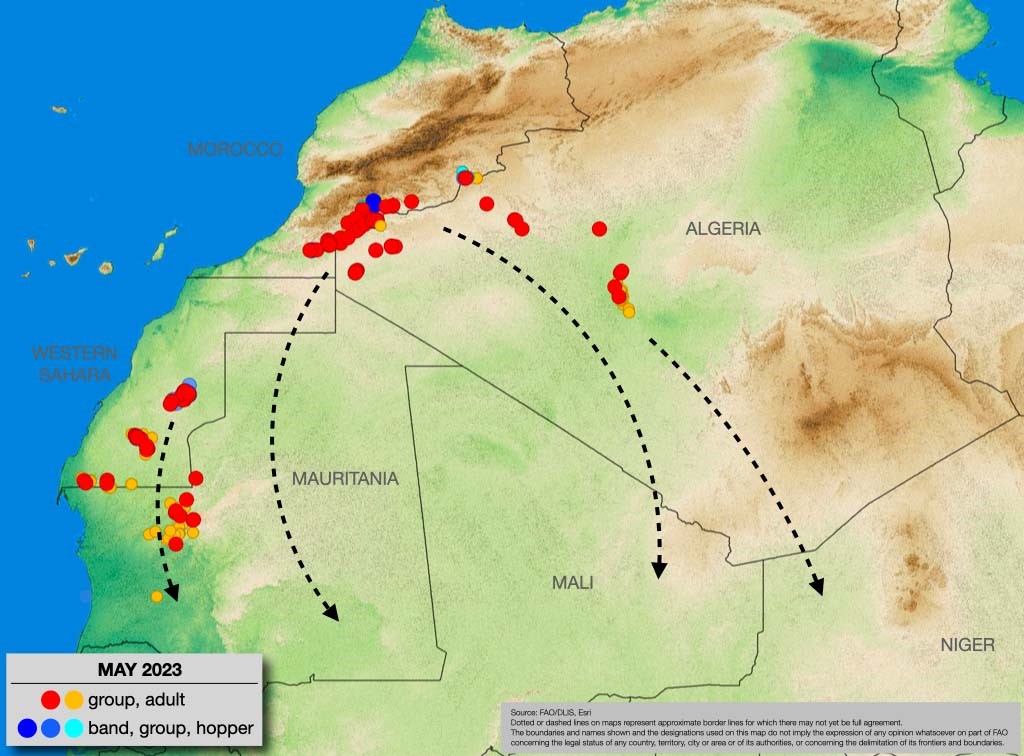
2 May 2023. An outbreak in Saudi Arabia
KEY POINTS
• Current situation: some hopper groups, bands, and adult groups in Saudi Arabia, Morocco, Western Sahara
• May: immature adult groups likely move to the interior of Saudi Arabia
• June–September: normal or slightly above normal rains in summer breeding areas for small-scale breeding in northern Sahel; normal or slightly below normal rain in interior Yemen and Indo-Pakistan
Although the Desert Locust situation was calm during April, a small outbreak developed on the Red Sea coast of Saudi Arabia where there were instar hopper groups, bands, and new immature adult groups as well as considerable air and ground control operations. During the forecast, immature adults and groups are expected to move into the interior of Saudi Arabia in early May where there was good rain in April. The adult groups will mature and lay eggs for another generation of breeding. Hatching could start in the second half of May.
In Northwest Africa, small hopper groups and bands occurred south of the Atlas Mountains in Morocco as well as further south in Western Sahara, and control was carried out. During the forecast, vegetation will start to dry, and the new immature adults will form small groups and move south. Weather models suggest that the summer season rains may start in the Sahel during June this year.
Elsewhere, low numbers of adults were present in Yemen, southeast Egypt, northwest Somalia, and southwest Pakistan. During the forecast period, small-scale breeding may occur in Yemen, southeast Iran, and southwest Pakistan.
No significant developments are likely.
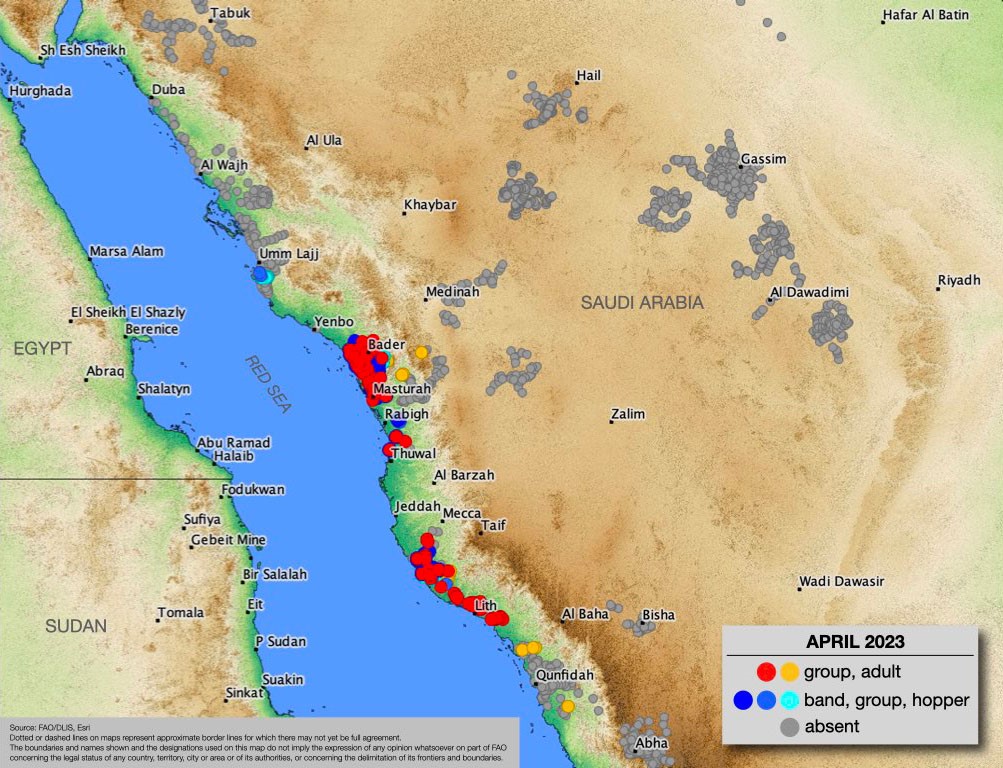
4 April 2023. Breeding occurs in Saudi Arabia
KEY POINTS
• Current situation: some hopper groups and bands in Saudi Arabia
• April: spring breeding on coast and interior of Saudi Arabia
• April–June: above-normal rains in Saudi Arabia, Yemen, Oman, Iran, Pakistan; below normal in northwest Africa
• July–September: normal or slightly above normal rains in summer breeding areas for small-scale breeding in northern Sahel; normal or slightly below normal rain in interior Yemen and Indo-Pakistan
________________________
The Desert Locust situation continued to remain calm during March.
Low numbers of solitarious adults and a few groups at the end of the winter season in Western Sahara, Morocco, Mauritania, Sudan, and Egypt. Hoppers hatched in two areas on the Red Sea coast of Saudi Arabia and small groups and bands formed. Low numbers of adults on the coast of Yemen.
During the forecast period, unusually good rains are expected on the coast and interior of Saudi Arabia in April which will allow a generation of spring breeding. Hopper groups and small bands will continue on the coast from April to mid-May, fledglings to start in early April, and adults could form groups and go to the interior. Elsewhere, small-scale is likely to occur south of the Atlas Mountains in Morocco, the interior of Yemen, in southeast Iran and southwest Pakistan, and perhaps in central Algeria, southwest Libya, and northern Oman if more rain falls.
No significant developments are likely.
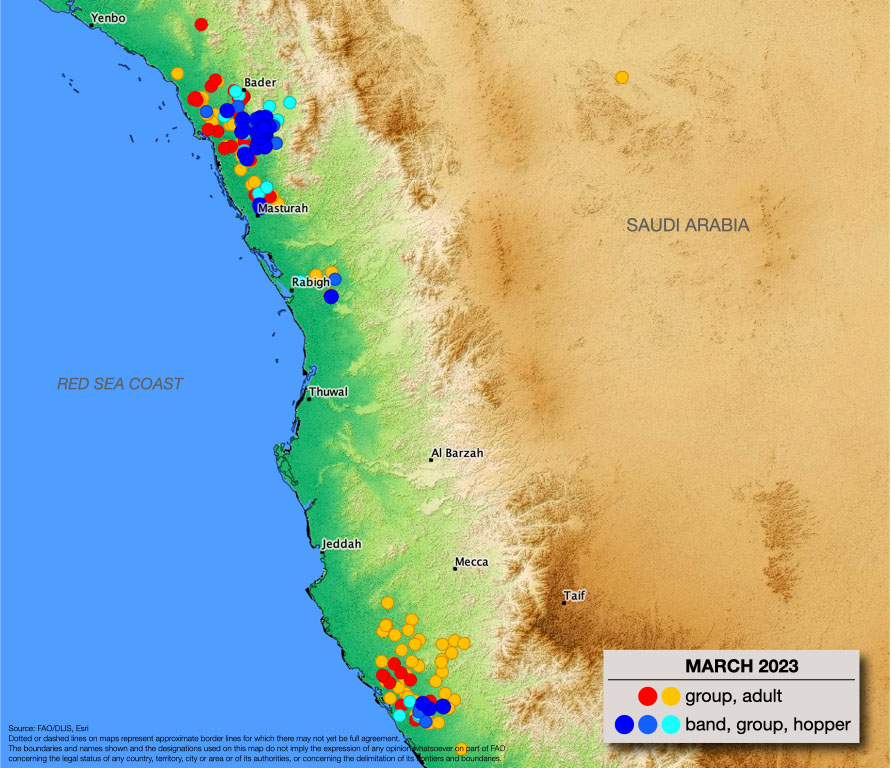
9 February 2023. Winter breeding will decline
KEY POINTS
• Current situation: calm in all regions
• January: In Sudan, adult groups increased in the Red Sea coast and subcoastal areas. In Saudi Arabia, a few mature groups of adults were copulating on the northern Red Sea coast. Low numbers of adults were present in southeast Egypt and the Red Sea coast of Yemen.
• March– mid April 2023: In Saudi Arabia, low numbers of adults are likely to move to the interior where good rains are supposed to fall. Rains are expected as well on the coast of southeast Iran and southwest Pakistan during March and April. Consequently, spring breeding may occur on a small scale.
The Desert Locust situation continued to remain calm during February.
In Sudan, adult groups increased in the Red Sea coast and subcoastal areas as vegetation started to dry out and ground teams treated 3 826 ha. In Saudi Arabia, a few mature groups of adults were copulating on the northern Red Sea coast where 410 ha were treated. Low numbers of adults were present in southeast Egypt and the Red Sea coast of Yemen. In the Eastern Region, good rain fell on the coast of Iran for the second month in a row.
In Saudi Arabia, low numbers of adults are likely to move to the interior where good rains are supposed to fall there as well as on the coast of southeast Iran and southwest Pakistan during March and April. Consequently, spring breeding may occur on a small scale.
Surveys and vigilance should be maintained for spring breeding activities.
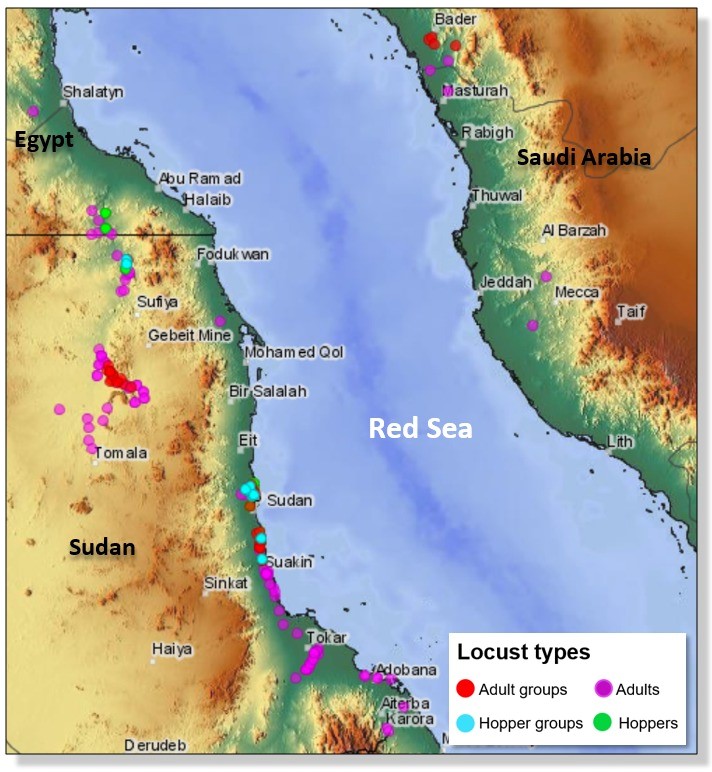
8 January 2023. Small outbreak continues in Mauritania
KEY POINTS
• Current situation: calm in all regions
• December: very small outbreak continued in northwest Mauritania
• January-mid-February 2023: No significant rainfall or vegetation is expected except perhaps in northern Mauritania and the central Red Sea coast of Saudi Arabia and maybe Sudan. Locusts will decrease in northwest and northern Mauritania.
The Desert Locust situation continued to remain calm during December.
The very small outbreak continues in northwest Mauritania where hoppers completed development after the first dekad and only groups of immature adults were present. Ground teams treated 2 264 and 562 ha in Mauritania and Morocco respectively. Low numbers of adults were seen in Niger, Algeria and Egypt. In Sudan and Yemen, low numbers of hoppers and adults were observed along the Red Sea coast and the Gulf of Aden.
During the forecast, locusts will decrease in northwest Mauritania due to control and only low numbers will remain. Similar, locusts should decrease in northern Mauritania. No significant rainfall or vegetation is expected in the next six weeks except perhaps in northern Mauritania and the central Red Sea coast of Saudi Arabia and maybe Sudan. Low numbers of hoppers and adults are likely to continue in the Red Sea coast of Sudan, Yemen, and perhaps Egypt. In Saudi Arabia, low numbers of adults may occur on the Red Sea coast and breed on a small scale. No significant development is likely.
Surveys and vigilance should be maintained in the winter breeding areas.
